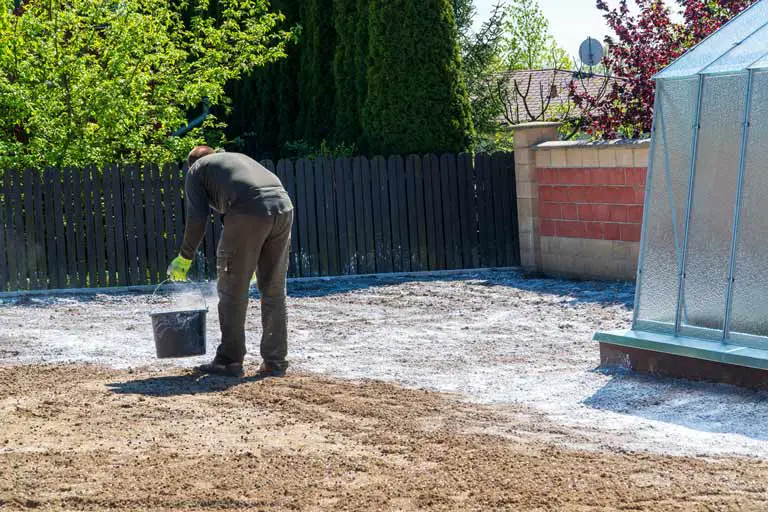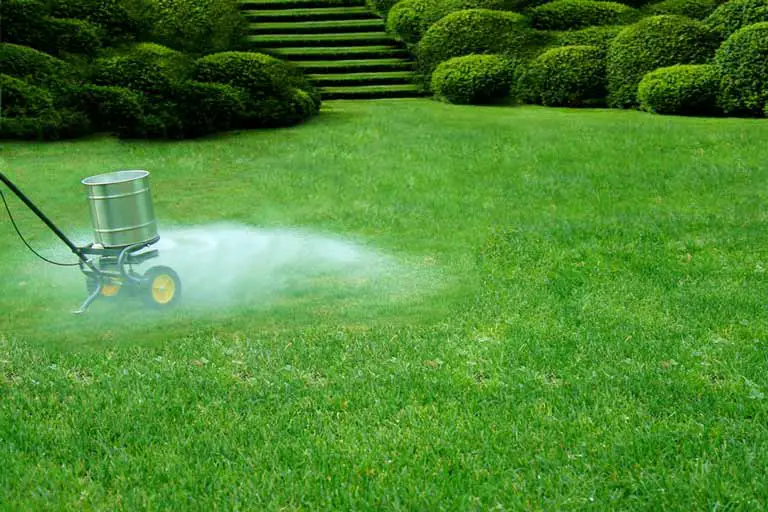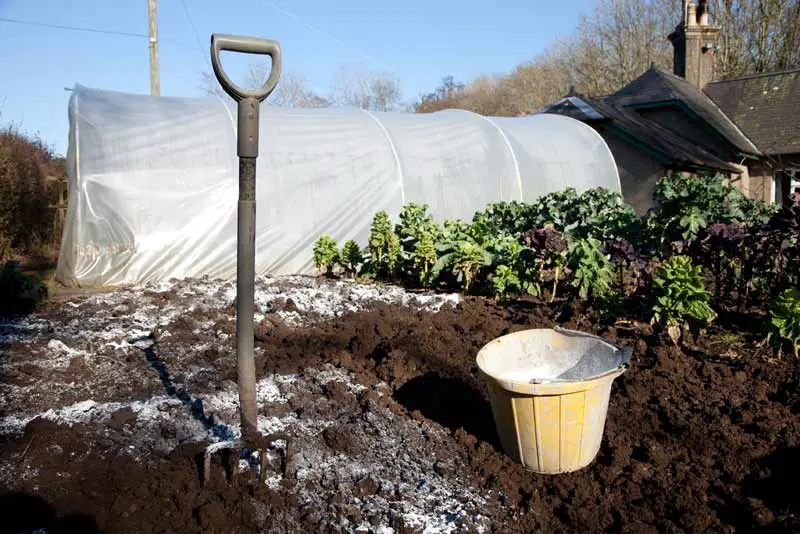
If you want to improve your plants’ health and yield, you may want to consider applying lime to your soil. Lime is a natural soil amendment that can have numerous benefits for your garden, including improving soil structure, increasing nutrient availability, and preventing certain plant diseases.
One of the main benefits of applying lime to soil is that it can help to balance the pH level. Soil pH is a measure of the acidity or alkalinity of the soil, and it plays a crucial role in determining which nutrients are available to plants. Most plants prefer a slightly acidic soil pH between 6.0 and 7.0, and if the pH is too low (acidic) or too high (alkaline), it can limit the uptake of essential nutrients.
Adding lime to your soil can help raise the pH level and create a more favourable growing environment for your plants.
What is Lime, and Why is it Important for Soil?
If you want to keep your soil healthy and productive, applying lime is one of the best things you can do. Lime is a soil amendment made from ground limestone rock, which is high in calcium and magnesium. When added to soil, lime helps raise the pH level, promoting the growth of microorganisms and making essential nutrients more available to plants.
Soil acidity is a major issue that can affect the health and productivity of your garden. When soil pH levels are too low, plants struggle to absorb nutrients like nitrogen, phosphorus, and potassium. This can lead to stunted growth, poor yields, and a range of other problems. Lime helps to neutralize soil acidity, making it easier for plants to access the nutrients they need to thrive.
In addition to improving soil pH levels, lime provides essential nutrients like calcium and magnesium. These nutrients are important for plant growth and development, helping to strengthen cell walls, promote photosynthesis, and support root growth. Adding lime to your soil can help ensure that your plants have access to the nutrients they need to grow strong and healthy.
Applying lime to your soil is a simple and effective way to promote healthy plant growth and improve soil productivity. Whether you’re growing vegetables, flowers, or other crops, adding lime to your soil can help ensure your plants have the nutrients they need to thrive.
How Lime Affects Soil pH Levels
Lime is a soil amendment that can help adjust the pH level of acidic soils. Soil pH is a measure of the acidity or alkalinity of soil and is measured on a scale of 0 to 14, with 7 being neutral. Soil pH affects the availability of nutrients in the soil and can impact plant growth and health.
When soil pH is too low or acidic, nutrients such as phosphorus, potassium, and calcium become less available to plants. This can result in stunted growth, yellowing leaves, and poor crop yields. Adding lime to soil can help raise the pH level and make these nutrients more available to plants.
Soil pH can be measured using a pH test kit or meter. If the pH level is below 6.0, adding lime to the soil may be beneficial. However, it’s important to note that adding too much lime can also harm plants, raising the pH level too high and making nutrients less available again.
The amount of lime needed to raise the soil’s pH level depends on several factors, including the type of soil, the current pH level, and the desired pH level. It’s important to follow recommended application rates and to retest soil pH periodically to ensure that the pH level remains within the desired range.
In summary, adding lime to soil can help raise the pH level of acidic soils, making nutrients more available to plants. However, it’s important to use caution and follow recommended application rates to avoid over-application and potential plant harm.
Related article: Builders Lime vs Garden Lime: What Are The Key Differences
When and How to Apply Lime to Soil
Applying lime to soil is important in maintaining healthy plants and grass. Knowing when and how to apply lime is crucial to ensuring your soil has the right pH balance. Here are some guidelines to follow:
Autumn Application
Autumn is the best time to apply garden lime to your soil. This gives the lime enough time to dissolve and raise the soil’s pH level before the next growing season. Before applying lime, it is important to test your soil’s pH level to determine how much lime is needed.
You can do this by taking a soil sample and sending it to a lab for testing for the most accurate readings. Additionally, you can purchase inexpensive pH tester kits like this one, enabling you to check soil pH yourself.
Once you know whether lime is needed, you can spread it evenly over your soil using a spreader. Wear gloves and a mask to protect yourself from the lime dust.
Spring Application
If you didn’t apply lime in the autumn, you can still apply it in the spring. However, it is important to apply it early enough in the season so that it has time to dissolve before the growing season begins. As with autumn application, you should test your soil’s pH level before applying lime and wear protective gear when spreading it.
Established Lawn Application
If you have an established lawn, you can apply lime whenever necessary. However, it is best to do so in the autumn or spring when the grass is not actively growing. If you need to apply more than 50 pounds (22kg) of lime per 1000 square feet, split the application into two, with 50 pounds in the autumn and 50 pounds in the spring. This will give the lime enough time to dissolve and raise the soil’s pH level without causing any harm to the grass.

Remember, applying lime to soil is important in maintaining healthy plants and grass. Following these guidelines ensures that your soil has the right pH balance and that your plants and grass will thrive.
Benefits of Applying Lime to Soil
Applying lime to the soil is a common practice among gardeners and farmers. It is an effective way to improve soil quality and ensure that plants grow healthy and strong. Here are some of the benefits of applying lime to soil:
Improved Nutrient Availability
The soil’s pH level plays a crucial role in determining the availability of nutrients to plants. The soil becomes acidic when the pH level is too low, and plants cannot absorb essential nutrients such as nitrogen, phosphorus, and potassium.
Applying lime to soil helps to increase the pH level, making it slightly less acidic and more alkaline. This, in turn, promotes the growth of beneficial bacteria that help to break down organic matter and release nutrients into the soil. As a result, plants can absorb these nutrients more easily, leading to healthier growth and better yields.
Promotes Healthy Plant Growth
When soil is too acidic, it can cause stunted growth, yellowing of leaves, and even death of plants. Applying lime to soil helps to neutralize acidity and create a more hospitable environment for plants. This promotes healthy growth, stronger roots, and better resistance to pests and diseases.
Additionally, lime helps improve soil structure by increasing water and air availability to plant roots, which is essential for healthy growth.
Reduces Moss and Weeds
Moss and weeds thrive in acidic soil, so applying lime can help to reduce their growth. Lime raises the soil’s pH level, making it less hospitable for these unwanted plants. This can help to reduce competition for nutrients and water, allowing your plants to grow more vigorously.
Enhanced Grass Growth
If you have a lawn, applying lime can help to promote healthy grass growth. Different types of grass have different pH preferences, but most prefer a pH level between 5.8 and 7.2. Applying lime can help adjust your soil’s pH level to this range, making it easier for grass to absorb essential nutrients and water. This can lead to thicker, greener grass that is more resistant to drought and disease.
Overall, applying lime to the soil is an effective way to improve the quality of the soil and promote healthy plant growth. Whether you are growing vegetables, flowers, or grass, adding lime to your soil can help ensure your plants thrive.
Related article: Is Lime Harmful to Soil? The Truth You Need to Know
How to Determine the Amount of Lime to Apply
If you want to apply lime to your soil, it is essential to determine the right amount of lime to apply. Applying too much or too little lime can negatively affect your soil and plants. Here are two factors to consider when determining the amount of lime to apply:
Soil Type
Your soil type plays a significant role in determining the amount of lime to apply. For example, clay soil requires more lime than sandy soil. This is because clay soil is more acidic and can hold onto the added lime for longer periods. On the other hand, sandy soil is less acidic and requires less lime.
Soil Test Results
The best way to determine the amount of lime to apply is by performing a soil test. A soil test will provide you with information about the pH level of your soil and the nutrients it lacks. The University of Arkansas, Cooperative Extension Service, recommends that you perform a soil test every three to four years.
When you receive your soil test results, look for the pH level. If the pH level is below 6.0, your soil is acidic and requires lime. The amount of lime you need to apply depends on the pH level and soil type.
The following table is based on using finely ground garden lime (calcium carbonate). The amount of lime suggested should be sufficient to raise the pH of your soil to around 6.5, a good all-around for most plants. Here are RHS’s recommendations for the amount of garden lime to apply:
| Soil pH | Sandy Soils (kg/m²) | Clay Soils (kg/m²) | Loam Soils (kg/m²) |
| 4.5 | 1.3 | 1.8 | 1.5 |
| 5.0 | 1 | 1.4 | 1.2 |
| 5.5 | 0.7 | 1 | 0.8 |
| 6.0 | 0.4 | 0.6 | 0.5 |
Make sure to apply the lime evenly across your soil. You can use a spreader to distribute the lime evenly.

Precautions and Considerations When Applying Lime to Soil
Application Rate
When applying lime to your soil, it is important to determine the correct application rate. This will depend on several factors, including the current pH of your soil, the type of soil you have (such as sand or clay), and the type of lime you are using.
It would be best to have your soil tested to determine the appropriate amount of lime to apply. Over-application of lime can lead to soil alkalinity, which can negatively affect plant growth.
Application Method
There are several methods for applying lime to your soil. The most common method is to spread the lime evenly over the soil surface and then incorporate it into the soil with a tiller or cultivator. Another method is to apply the lime in a liquid form through irrigation systems. Following the manufacturer’s instructions for the proper application method and rate is important.
Safety Considerations
When handling lime, it is important to take certain safety precautions. Lime can be caustic and can cause skin and eye irritation, especially if you use a more potent form of lime, such as builders’ lime. You should wear protective clothing, such as gloves and goggles, when handling lime.
It is also important to avoid inhaling lime dust, as it can cause respiratory irritation. When applying lime, it is recommended that you work on a calm day to avoid wind drift and wear a dust mask if necessary. In addition, it is important to consider the type of lime you use.
Dolomite lime contains magnesium, which can benefit certain soil types but is not recommended for soils with high magnesium levels. It is important to research the type of lime best for your specific soil type and needs.
Applying lime to your soil can have many benefits, such as reducing soil acidity and improving nutrient availability. However, it is important to take precautions and consider the appropriate application rate and method to ensure the best results for your garden or crops.
Conclusion
You have learned about the benefits of applying lime to the soil. Incorporating lime into your lawn care routine can help to add nutrients to the soil, promote the spread of good bacteria, and improve the availability of plant nutrients.
However, it is important to note that adding lime to soil with a pH of 6.5 or higher is not recommended, as it can make important nutrients even harder for plants to absorb.
It is also crucial to apply lime at the right time, such as in the autumn when the freeze-thaw cycles and abundant rain and snow can help break down the lime and raise the soil’s pH. Lime should never be applied to a lawn that is stressed or dormant.
Following these guidelines ensures that your lawn and garden thrive with healthy, nutrient-rich soil.

